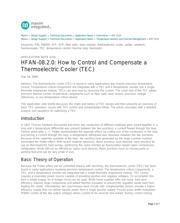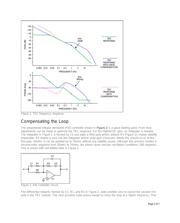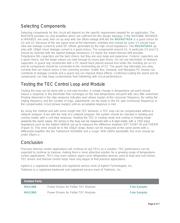herunterladen

Maxim > Design Support > Technical Documents > Application Notes > Automotive > APP 3318
Maxim > Design Support > Technical Documents > Application Notes > Temperature Sensors and Thermal Management > APP 3318
Keywords: PID, DWDM, SFF, SFP, fiber optic, laser module, thermoelectric cooler, peltier, seebech,
thermocouple, TEC, temperature control, thermal loop, thermistor
APPLICATION NOTE 3318
HFAN-08.2.0: How to Control and Compensate a
Thermoelectric Cooler (TEC)
Sep 16, 2004
Abstract: The thermoelectric cooler (TEC) is found in many applications that require precision temperature
control. Temperature-critical components are integrated with a TEC and a temperature monitor into a single
thermally engineered module. TECs can also heat by reversing the current. The small size of the TEC allows
precision thermal control of individual components such as fiber-optic laser drivers, precision voltage
references, or any temperature-critical device.
This application note briefly discusses the origin and history of TEC design and then presents an overview of
basic TEC operation. Issues with TEC control and compensation follow. The article concludes with a detailed
analysis and equations for optimizing a TEC.
Introduction
In 1821 Thomas Seebeck discovered that when two conductors of different materials were joined together in a
loop and a temperature differential was present between the two junctions, a current flowed through the loop.
Twelve years later, J. C. Peltier demonstrated the opposite effect: by cutting one of the conductors in the loop
and forcing a current through the loop, a temperature differential was observed between the two junctions.
Because of the materials available at the time, the resistive heat generated by the large currents involved
dominated the Peltier effect. With recent material advances, these junctions have become more practical for
use as thermoelectric heat pumps, performing the same function as fluorocarbon-based vapor compression
refrigeration. While still not as efficient as vapor-cycle devices, these junctions have no moving parts or
working fluid and can be very small in size.
Basic Theory of Operation
Because the Peltier effect can be controlled linearly with electricity, the thermoelectric cooler (TEC) has been
found in many applications involving precision temperature control. The temperature-critical components, a
TEC, and a temperature monitor are integrated into a single thermally engineered module. TEC control
requires a reversible power source capable of providing positive and negative voltages. To accomplish this
from a single supply, an H-bridge circuit can be used. While linear supplies offer low noise, their poor
efficiency requires large components and added thermal insulation to prevent the regulator waste heat from
loading the cooler. Alternatively, two synchronous buck circuits with complementary drivers provide a higher
efficiency supply that can deliver bipolar power from a single positive supply. Forced pulse-width-modulation
(PWM) control of the two output voltages allows current to be sourced and sinked. During current sinking,
Page 1 of 7








